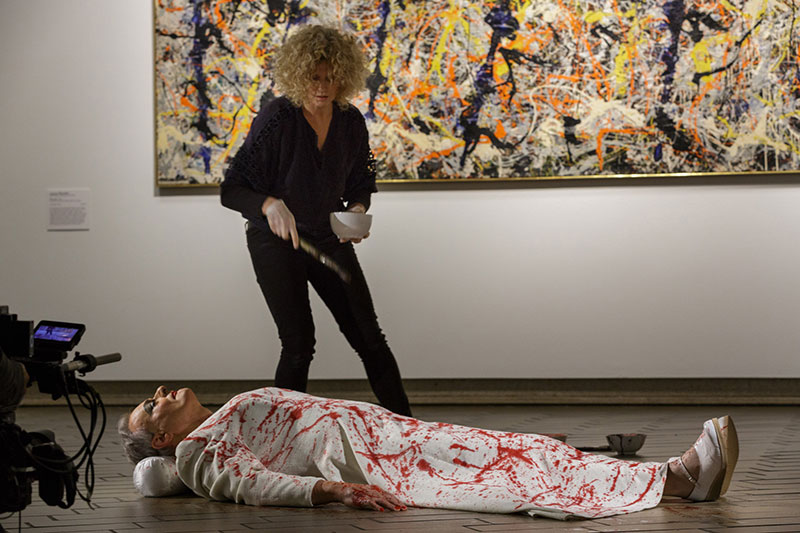
Body Time

introduction
In this paper I want to look at a few case studies from recent Australian performance art, to examine the ways in which video performance is being presented and to look at several genres inside the medium.
-
Category
Performance Art, Video -
Published In
This Article first appeared in Art+Australia, 2016. -
Year
2016
Body
Time
The collaborative team of Fiona McGregor and AñA Wojak, and solo artist Catherine Bell, present abject work where blood is spilt and the human animal threshold is crossed. In the first example the performance is presented live and created as a separate video projection, in Bell’s case the durational performance is exclusively to camera. Performances by Nasim Nasr and Eugenia Raskopoulous use video as a tool for the exploration of feminine writing and translation, while Simone Hine draws on her knowledge of cinema and screen history to re-perform stereotypes of the feminine which are then deconstructed through repetition and displacement. The new form of performance art presented by these artists demonstrates that the abject qualities of extreme body art can be experienced through its re-performance on video. Although some sensual aspects such as smell may be lost, the camera is able to bring the viewer closer to the event thus intensifying the visual experience.
Performance art made for screen is a relatively recent medium in the history of contemporary art and one that has arisen concurrently with debates around ‘liveness’. This concerns whether or not you have to be there to truly appreciate the work and the role video and photographs play in reconstructing events. The scholarship in this area is fascinating and worthy of serious attention, but what’s really interesting is the way in which video performance art developed in relation to this dialogue.1
On one hand there are the historical records. Old black and white photographs and grainy magnetic tape that are often difficult to fathom or play, not least of all because the photographs are fragments and machines to play ½ and ¾ inch tape are hard to get hold of. This means we are looking at an archival problem and actually getting to see any image or footage is a bonus. These historical documents are certainly valuable both artistically and in terms of the art market but they are made more intriguing by the dialogue that now surrounds the field of performance art documentation.
On the other hand video technology was much improved by the 1990s and it wasn’t long before performance artists were making quality productions that were carefully edited as single and multiple-screen projections for gallery and festival presentation. These videos were often variations of the live performance and were made specifically for the camera; some were made exclusively for video with no ‘real time’ performance or attending audience. Practice thus made an incursion into the theoretical debates – it was as if artists noticed the scholarly work around the ‘liveness debates’ and were enlivened by it. Instead of persisting with the supposed integrity of the ontological experience – ‘you had to be there’ – they grasped the ideas and created a different form of performance art, one which embraced the camera and screen and utilised these tools to create new work with a different emphasis. As artists recognised and played with the reproducibility of performance video, they started to re-examine the once precious notion of performance being a unique event and shortly afterwards we see the rise of the re-make and later delegated performances where artists re-perform their own or other artists’ works.
In the works discussed below the body-time relation is being reconfigured and retold through the form itself. In these video performances artists explore the relationship between the body and the lens in various ways and with different emphasis. The camera brings the abject closer to the viewer; editing techniques allow for trace elements to have a presence; the camera can be worn on the body to create a visuality through touch, and time can be slowed downed in order to re-examine the visual. This is an exciting new medium that challenges the established thinking around live performance and its presence.
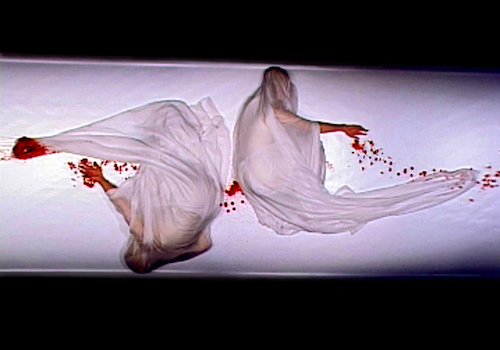 senVoodoo (Fiona McGregor and AñA Wojak)Arterial, 2005 Video still from three-screen installation.
senVoodoo (Fiona McGregor and AñA Wojak)Arterial, 2005 Video still from three-screen installation.
From 1999 until 2008 Fiona McGregor and AñA Wojak collaborated as a performance art duo under the name of senVoodoo. In 2005 they first conceived Arterial as a three-channel video and then in 2006 they developed the work as a live performance which they toured throughout Poland. In 2008 the work was performed live at the Experimental Art Foundation in Adelaide where the video installation was also shown.
Arterial presents two women shrouded in white, their faces and bodies covered in a translucent material. They walk slowly towards one another with their arms extended. It is a Butoh-like walk—each step is almost imperceptible, a measured shuffle. The soundtrack is ethereal, comprised of the sounds of the inside of the body: blood pulse, breathing, and heartbeat. They walk on a long white scroll of photographic paper and both have cannulas in the veins of their wrists. As they spill their blood, it splashes onto the photographic emulsion where it binds together and congeals, allowing the scroll to be exhibited as a residue of the ritual. McGregor says that the performance is about loss and mourning, but she also refers to herself as a secular Catholic and notes that Wojak brought Catholic iconography to their collaborative works.2 There is certainly a redemptive quality to the ritual that situates it within a long history, most specifically within the context of ritual in performance art. However there is also a very private aspect to this collaboration, a pact or contract between the two women who were once lovers. McGregor is Hepatitis C positive and in this sense the blood she spills is ‘bad blood’, contaminated and diseased. As the two women come together at the climax of the performance, they do not touch. Wary of contamination, they turn away from each other and face into the path of their own blood.
The shrouds worn by the female figures conjure up images of virgin brides and veiled women. The full-length garment could be seen as a white burka but the translucent material reveals the bodies beneath. The mix of codes presents a powerful dichotomy. On one hand the blood-letting for McGregor is redemptive, a quasi-religious absolution for her past sins, but in this instance the spilling of blood conjures the draining of life from the bride(s) who traditionally promise to bring life into the world. The ultra-feminine burka-like robes, which clearly show their sexualised bodies beneath, liberate the female bodies from their cultural confinements. The failure to conceal the bodies of the veiled women was particularly pertinent in Poland, which McGregor describes as a profoundly homophobic society. The women literally bare themselves and yet they are not seen, their homosexuality is invisible.
Catherine Bell
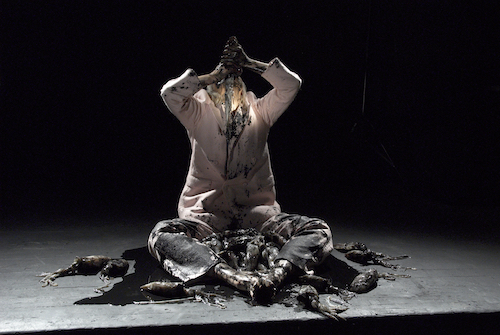 Catherine BellFelt is the Past Tense of Feel, 2006, performance still. Two channel video projection. Courtesy of the artist and Sutton Gallery. © The Artist. Photograph Christian Capuro.
Catherine BellFelt is the Past Tense of Feel, 2006, performance still. Two channel video projection. Courtesy of the artist and Sutton Gallery. © The Artist. Photograph Christian Capuro.
In 2006, a fair-haired woman sits astride a pile of forty dead squid with their eyes, tentacles, suckers and ink sacs intact. She is dressed in a pink felt suit which she has fastened over a suit that her father wore to weddings and funerals. I am watching a video-performance by Catherine Bell titled Felt is the Past Tense of Feel. The performance was set in a town hall where the stage area was painted black so as to create a kind of void. The female figure and the squid are brightly lit and in the video Bell proceeds to suck the ink out of each animal and spit it out over the suit until it is almost saturated in black. She rubs the ink over her hands and face and gathers all the forty squid bodies towards her, stuffing some inside the jacket and slowly shuffles backwards beyond the spotlights and fades to black. This endurance work lasts sixty minutes and is recorded in ‘real time’ on video with a static video camera.
The performance is primarily a cathartic and empathetic response to her father’s death. She says “I imagine my father’s body dressed in the coffin. The outfit would be drenched by bodily fluids just as the suit I wore for the performance is now stained and stiffened by the squid ink”.3 The outer felt suit was subsequently exhibited as a relic of the performance “to symbolize the ghostly presence of the father and evoke the stench of his body breaking down”.4
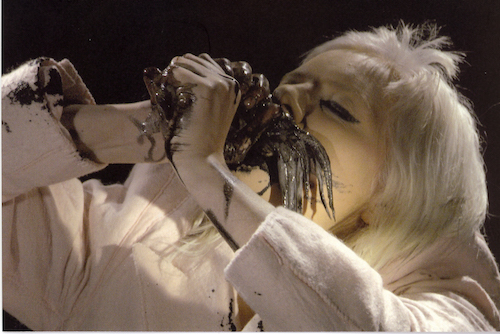 Catherine Bell Felt is the Past Tense of Feel, 2006, performance still. Two channel video projection. Courtesy of the artist and Sutton Gallery. © The Artist. Photograph Christian Capuro.
Catherine Bell Felt is the Past Tense of Feel, 2006, performance still. Two channel video projection. Courtesy of the artist and Sutton Gallery. © The Artist. Photograph Christian Capuro.
The autobiographical content of Bell’s Felt is the Past Tense of Feel is not immediately apparent to the viewer of the video. The catharsis and the abjection of the work are contained within the relation between the female figure and the dead animals. Although the video is silent, the physical action of sucking the ink induces disgust as we see the artist making contact with each individual beak and we envisage the eye contact that must be taking place. Bell says:
I respond to the animal as if it is unconscious or recently deceased because the ink sacs remain active waiting to squirt out involuntarily when handled. Sucking out the ink involved positioning my mouth over the squid’s beak and then our eyes would meet.5
Nasim Nasr
In Erasure (2010) – a live performance re-mediated for dual channel video – Nasim Nasr is dressed in a chador and writes on a black chador which has been stretched like a fanned-out canvas across the wall. She recounts her memories as a young woman living in Iran which she writes from right to left in Farsi with white chalk. She then starts writing from left to right in English, interspersing the words of the notorious Iranian feminist poet Forugh Farrokhzad, who published modern verse about women. Once the whole text is written it is crossed through and then erased leaving a residue of white markings which are no longer decipherable. In the video version, the figure of Nasr is doubled so that the writing in Farsi and English occur concurrently and on the second screen there is a close up sequence of a woman’s hand erasing the Farsi text as it is being written by another hand.
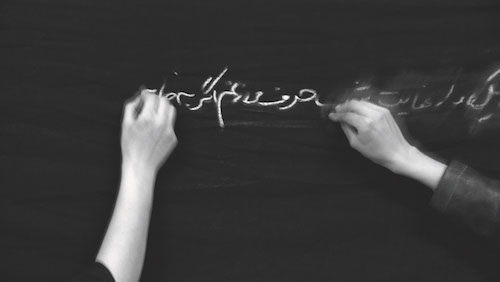 Nasim Nasr,Erasure (2010), video performance, right channel.
Nasim Nasr,Erasure (2010), video performance, right channel.
In Erasure, Nasr says she wanted to set up “a rhythm of performed oppositions: negative/positive, black/white, past/present, memory/forgetting, speech/silence [and] darkness/hope”.6 Erasure is concerned with a feminine writing on the shrouded body – what she writes is erased by herself, and in the video version this self is split and she appears to be another woman. According to the artist the work points to women in Iran erasing themselves, their memories and histories, and participating in their own oppression through compliance.7
Eugenia Raskopoulos
Eugenia Raskopoulos, an artist of Greek heritage, is concerned with language, writing and translation. Using her own body she produces visceral performances exclusively for video. The writing she presents on screen often appears feminised or at least it conjures a language of or about woman. Raskopoulos employs haptic sound in many of her video performances: a sound that is taken from the body’s touch.
In Re-Departing (1995), the power of a feminine language – of resistance and oppression – is inscribed via Raskopoulos’s body onto the landscape to create a compelling though abstracted narrative. Re-Departing is a single channel video in the context of an installation consisting of one hundred and thirteen small tins glowing with red oil and arranged in a Greek cross. The room is a memorial. The video shows a woman’s feet in simple black shoes and part of the black dress she is wearing. She also wears the video camera over her shoulder, it hangs freely and captures the ground as she moves very slowly up a hill. The ground is mostly barren with old rocks and some ancient steps. She has returned to Greece to the village of Zalongo in Epirus and she is walking up the bluff above the convent to the site where over sixty women and children jumped to their deaths during the Souliote War of 1803 to escape persecution.8 It is said that the women and children sought refuge at the convent but when the soldiers came they climbed the bluff and once there performed their national dance and then “threw themselves together with their children over the precipice”.9
Raskopoulos uses the medium of video to inscribe language as an inside-out form of communication: the video eye literally touches the landscape. In Merleau-Ponty’s terms the eye/the body touches the touched and this phenomenology is like a glove and its fingers.10 This is, of course, the feminine: a touching of the other inside itself, a doubling.11 It is a language of a body which is not one: a woman’s body, seeping and never contained.
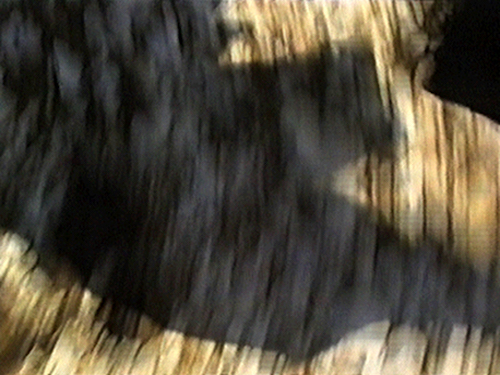 Eugenia Raskopoulos Re-Departing (still), 1995, video, sound 8:37 minutes. Courtesy of the artist, Kronenberg Wright. Artists Projects, Sydney and Arc One Gallery Melbourne.
Eugenia Raskopoulos Re-Departing (still), 1995, video, sound 8:37 minutes. Courtesy of the artist, Kronenberg Wright. Artists Projects, Sydney and Arc One Gallery Melbourne.
A woman walks up a hill, we see only glimpses of her dress, her shoes. She whispers names to us caught with the wind: “Annastasia . . . Alexandria . . . Eleni . . . Polixeni . . . Zoe . . . Elena . . . Athina . . . Andonia . . . Konstantina . . . Aphrodite . . . Krisoula . . . Maria . . . Theodora”. Through the haptics of the video screen and the soundtrack she channels the women who walked the path before her, who sacrificed everything, killing their own children in the ecstasy of the dance routine and plummeting into the abyss over three hundred years ago. The video camera scans the land – it is uncontrolled, moving freely with her body as she walks – it picks out scars, fissures, wounds. It is as if the land itself remembers the pathos and the killing. Complex words now appear on the screen: monologism, etymology, pathos, heterogeneous, autonomous, enantiomorph, pausilypon, metronymic, thanatos. Stamping the landscape with their rationality and their lofty importance, these words fail. There is no way to talk or write about this work without becoming part of it. The artist falls: she crashes against the structure of language, but refuses to become mute. She bears the load of language and attempts, often successfully, to trick it into meaning: to speak of an Other who traditionally cannot be spoken.
Simone Hine
Simone Hine approaches video performance from a different perspective. She considers her work to be an extension of constructed (performative) photography and situates it between the visual arts and cinema.12 Hine is interested in the concept of para-narrative and the stillness of the photograph which arrests time. She is concerned with the medium of film and its relation to photography, especially digital video which makes it possible to freeze the moving image outside the editing room. Hine argues that this capacity means that we are now able to talk about the punctum of and in film. Drawing on Laura Mulvey and Garrett Stewart, Hine looks at the materiality of film and the way in which it is predicated on the still image and she argues that by fragmenting cinema it becomes more aligned to the visual arts.13 She is also interested in film genre and in some works pays particular attention to costume.
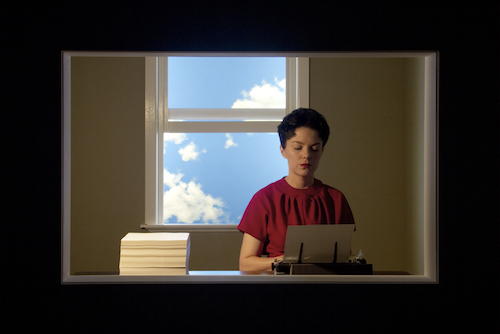 Simone Hine Timepiece (Kings ARI, 2011) Video and performance installation.
Simone Hine Timepiece (Kings ARI, 2011) Video and performance installation.
Timepiece (Kings, 2011) involved screen images and live performance over the three spaces of the L-shaped gallery. The viewer enters the space and encounters a screen showing a vivid blue sky with white clouds, a ball of crunched up paper occasionally flies across the sky. Turning to the left the viewer enters another space – a constructed office built within the room, complete with fake window and the same blue sky as seen on the video screen. Hine, expertly costumed in the style of a 1950’s secretary, sits at an antique typewriter and beside her is a huge stack of white paper. She types on the page, notices a mistake, withdraws the page, crumbles it up and tosses it out the fake window behind her. This action continues throughout the working day. There is a gap between the constructed office window and the painted blue sky which holds all the errors from the day. In the final room an old clock hangs high on the wall picked out of the dark room with a single spotlight, reminiscent of the hundreds of similar shots in Hollywood cinema.
It is clear that Simone Hine is carving out a particular style of performance video that situates itself within the history of cinema more than within the history of performance art. Her mentors are filmmakers yet she aspires to slow cinema time, to bring attention to the lost fragments, especially those moments where women are seen in the background of the main story or they are the victims of a conventional narrative.
Conclusion
Performance art theory has often stressed the ontology of performance – its being in time – but in this essay I hope to have demonstrated that many women artists practicing in the field are now producing video performance and thus exploring a different position in relation to time. The works discussed here also indicate that the radical edge of body art can certainly be transferred via video. It is not the same as the live performance but in some ways it enhances the feeling of ‘liveness’ for a distant audience by bringing the action closer to the viewer. The new medium of video performance adds another dimension to the practice of performance art by embracing the moving image and at times its histories. Although live performance will continue to navigate various paths, it is clear that performance on video is appealing for many artists and the visual strength of the screen medium is able to put the viewer in an intimate space with the artist.
Endnotes
- See Amelia Jones, “Presence in Absentia: Experiencing Performance as Documentation”, Art Journal, 56:4 (Winter, 1997) pp. 11-18; Peggy Phelan, “The Ontology of Performance”, in Unmarked: The Politics of Performance (New York and London: Routledge, 1993) pp. 146-166. ↩
- Fiona McGregor, Strange Museums: A Journey through Poland (Crawley, WA: University of Western Australia Press, 2008) p. 175. ↩
- Catherine Bell, Liminal Gestures: Ritualising the Wound through Performance and Lived Experience (PhD Thesis Monash University) p. 127. ↩
- ibid. ↩
- ibid., p. 127. ↩
- Nasim Nasr, statement received by the author 11 August 2012 ↩
- Anne Marsh, Interview with Nasim Nasr (Adelaide, 10 August 2012). ↩
- George Alexander, “Re-Departing”, as published on Raskopoulos’ website http://eugeniaraskopoulos.com/essays/re-departing/ ↩
- Ibid. ↩
- Maurice Merleau-Ponty, “The Intertwining – The Chiasm” in The Visible and the Invisible, trans. Alphonso Lingis (Evaston: Northwestern University Press, 1968) pp. 133-134. ↩
- Luce Irigaray, This Sex Which Is Not One (Ithica, NY: Cornell University Press) 1985. ↩
- Anne Marsh, Interview with Simone Hine (Melbourne, 21 October 2011). ↩
- Simone Hine, ibid. See: Laura Mulvey, Death 24x a Second: Stillness and the Moving Image (London: Reaktion Books, 2006); Garrett Stewart, Between Film and Screen: Modernism’s Photo Synthesis (Chicago and London: The University of Chicago Press) 1999. ↩
